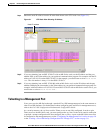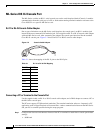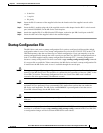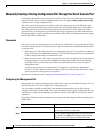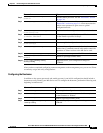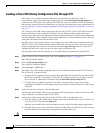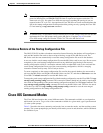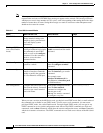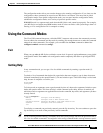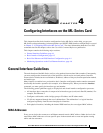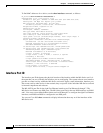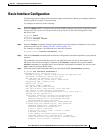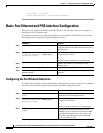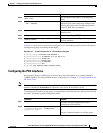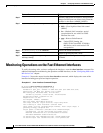
3-11
Cisco ONS 15310-CL and Cisco ONS 15310-MA Ethernet Card Software Feature and Configuration Guide R8.5
78-18133-01
Chapter 3 Initial Configuration of the ML-Series Card
Using the Command Modes
The configuration modes allow you to make changes to the running configuration. If you later save the
configuration, these commands are stored across ML-Series card reboots. You must start in global
configuration mode. From global configuration mode, you can enter interface configuration mode,
subinterface configuration mode, and a variety of protocol-specific modes.
ROMMON mode is a separate mode used when the ML-Series card cannot boot properly. For example,
your ML-Series card might enter ROM monitor mode if it does not find a valid system image when it is
booting, or if its configuration file is corrupted at startup.
Using the Command Modes
The Cisco IOS command interpreter, called the EXEC, interprets and executes the commands you enter.
You can abbreviate commands and keywords by entering just enough characters to make the command
unique from other commands. For example, you can abbreviate the show command to sh and the
configure terminal command to config t.
Exit
When you type exit, the ML-Series card backs out one level. In general, typing exit returns you to global
configuration mode. Enter end to exit configuration mode completely and return to privileged EXEC
mode.
Getting Help
In any command mode, you can get a list of available commands by entering a question mark (?).
Router> ?
To obtain a list of commands that begin with a particular character sequence, type in those characters
followed immediately by the question mark (?). Do not include a space. This form of help is called word
help, because it completes a word for you.
Router# co?
configure
To list keywords or arguments, enter a question mark in place of a keyword or argument. Include a space
before the question mark. This form of help is called command syntax help, because it reminds you
which keywords or arguments are applicable based on the command, keywords, and arguments you have
already entered.
Router# configure ?
memory Configure from NV memory
network Configure from a TFTP network host
overwrite-network Overwrite NV memory from TFTP network host
terminal Configure from the terminal
<cr>
To redisplay a command you previously entered, press the Up Arrow key. You can continue to press the
Up Arrow key to see more of the previously issued commands.
Tip If you are having trouble entering a command, check the system prompt, and enter the question mark (?)
for a list of available commands. You might be in the wrong command mode or using incorrect syntax.



